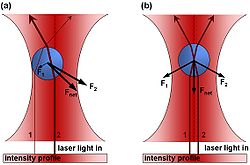
Optical levitation
Encyclopedia

Arthur Ashkin
Arthur Ashkin is a retired scientist who worked at Bell Laboratories and Lucent Technologies. He has started his work on manipulation of microparticles with laser light in the late 60s which has resulted in the invention of optical tweezers in 1986. He has pioneered the optical trapping process...
whereby a material is levitated
Levitation
Levitation is the process by which an object is suspended by a physical force against gravity, in a stable position without solid physical contact...
against the downward force of gravity by an upward force stemming from photon
Photon
In physics, a photon is an elementary particle, the quantum of the electromagnetic interaction and the basic unit of light and all other forms of electromagnetic radiation. It is also the force carrier for the electromagnetic force...
momentum
Momentum
In classical mechanics, linear momentum or translational momentum is the product of the mass and velocity of an object...
transfer. Typically photon radiation pressure
Radiation pressure
Radiation pressure is the pressure exerted upon any surface exposed to electromagnetic radiation. If absorbed, the pressure is the power flux density divided by the speed of light...
of a vertical upwardly directed and focused laser beam of enough intensity counters the downward force of gravity to allow for a stable optical trap
Optical tweezers
Optical tweezers are scientific instruments that use a highly focused laser beam to provide an attractive or repulsive force , depending on the refractive index mismatch to physically hold and move microscopic dielectric objects...
capable of holding small particles in suspension.
Micrometer sized (from several to 50 micrometer in diameter) transparent dielectric
Dielectric
A dielectric is an electrical insulator that can be polarized by an applied electric field. When a dielectric is placed in an electric field, electric charges do not flow through the material, as in a conductor, but only slightly shift from their average equilibrium positions causing dielectric...
spheres such as fused silica spheres, oil or water droplets, are used in this type of experiment. The laser radiation can be fixed in wavelength
Wavelength
In physics, the wavelength of a sinusoidal wave is the spatial period of the wave—the distance over which the wave's shape repeats.It is usually determined by considering the distance between consecutive corresponding points of the same phase, such as crests, troughs, or zero crossings, and is a...
such as that of an argon ion laser or that of a tunable dye laser
Dye laser
A dye laser is a laser which uses an organic dye as the lasing medium, usually as a liquid solution. Compared to gases and most solid state lasing media, a dye can usually be used for a much wider range of wavelengths. The wide bandwidth makes them particularly suitable for tunable lasers and...
. Laser power
Power (physics)
In physics, power is the rate at which energy is transferred, used, or transformed. For example, the rate at which a light bulb transforms electrical energy into heat and light is measured in watts—the more wattage, the more power, or equivalently the more electrical energy is used per unit...
required is of the order of 1 Watt
Watt
The watt is a derived unit of power in the International System of Units , named after the Scottish engineer James Watt . The unit, defined as one joule per second, measures the rate of energy conversion.-Definition:...
focused to a spot size of several tens of micrometers. Phenomena related to morphology-dependent resonance
Morphology-dependent resonance
Resonances found in certain types of optical cavity that are cylindrical, spherical, and ellipsoidal in shape. Conditions under which the resonances occur dependent on shape as well as refractive index of material within the optical cavity, and normally characterized by two integers, namely, order...
s in a spherical optical cavity
Optical cavity
An optical cavity or optical resonator is an arrangement of mirrors that forms a standing wave cavity resonator for light waves. Optical cavities are a major component of lasers, surrounding the gain medium and providing feedback of the laser light. They are also used in optical parametric...
have been studied by several research groups.
For a shiny object, such as a metallic micro-sphere, stable optical levitation has not been achieved.
See also
- Electrostatic levitationElectrostatic levitationElectrostatic levitation is the process of using an electric field to levitate a charged object and counteract the effects of gravity. It was used, for instance, in Robert Millikan's oil drop experiment and is used to suspend the gyroscopes in Gravity Probe B during launch.Due to Earnshaw's...
- Magnetic levitationMagnetic levitationMagnetic levitation, maglev, or magnetic suspension is a method by which an object is suspended with no support other than magnetic fields...
- Acoustic levitationAcoustic levitationAcoustic levitation is a method for suspending matter in a medium by using acoustic radiation pressure from intense sound waves in the medium. Acoustic levitation is possible because of the non-linear effects of intense sound waves....
- Aerodynamic levitationAerodynamic levitationAerodynamic levitation is the use of gas pressure to levitate materials so that they are no longer in physical contact with any container. In scientific experiments this removes contamination and nucleation issues associated with physical contact with a container.-Overview:The term aerodynamic...
- Laser propulsionLaser propulsionLaser propulsion is a form of beam-powered propulsion where the energy source is a remote laser system and separate from the reaction mass...

